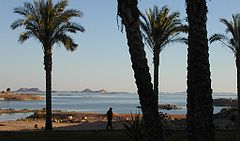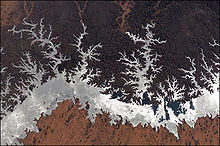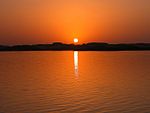- Lake Nasser
-
Lake Nasser 
View from Abu Simbel 
Map showing the location of the lake Coordinates 22°25′N 31°45′E / 22.417°N 31.75°ECoordinates: 22°25′N 31°45′E / 22.417°N 31.75°E Lake type Reservoir Primary inflows Nile Primary outflows Nile Basin countries Egypt, Sudan Max. length 550 km (340 mi) Max. width 35 km (22 mi) Surface area 5,250 km2 (2,030 sq mi) Average depth 25.2 m (83 ft) Max. depth 180 m (590 ft) Water volume 132 km3 (51,000 sq mi)[1] Shore length1 7,844 km (25,735,000 ft) Surface elevation 183 m (600 ft) References [1] 1 Shore length is not a well-defined measure. Lake Nasser (Arabic: بحيرة ناصر Buhayrat Nasir, Egyptian Arabic: [boˈħeːret nɑːsˤeɾ]) is a vast reservoir in southern Egypt, and northern Sudan, and is one of the largest man-made lakes in the world. Strictly, "Lake Nasser" refers only to the much larger portion of the lake that is in Egyptian territory (83% of the total), with the Sudanese preferring to call their smaller body of water Lake Nubia (Arabic: بحيرة نوبية; transliterated: Buhayrat Nubiya). The area of Sudan-administered Wadi Halfa Salient was largely flooded by Lake Nasser/Lake Nubia.
The lake was created as a result of the construction of the Aswan High Dam across the waters of the Nile between 1958 and 1971. The lake is named after Gamal Abdel Nasser, one of the leaders of the Egyptian Revolution of 1952, and the second President of Egypt, who initiated the High Dam project.
Contents
Description
The lake is some 550 km long and 35 km across at its widest point, which is near the Tropic of Cancer. It covers a total surface area of 5,250 km² and has a storage capacity of some 157 km³ of water.
History
Construction of the High Dam was one of the chief priorities of the revolutionary government in Egypt after the overthrow of the King Farouk in 1952. Under Egypt's first president, Muhammad Naguib, planning was initiated for constructing a new dam at Aswan that would both guarantee Egypt's water security, and assist in the industrialisation of the country by providing a source of hydro-electric power. Planning was continued under his successor as President, Gamal Abdel Nasser, under whose tenure the withdrawal of funding from the project by the governments of the United States, and the United Kingdom contributed to Egypt's nationalisation of the Suez Canal, and the subsequent Tripartite Aggression.
Nasser died in 1970, and upon completion of the Dam during the presidency of Nasser's successor, Anwar El-Sadat, the resulting lake was named in Nasser's honour.
When Lake Nasser was being created as a result of the construction of the Aswan High Dam, across the Nile, between 1958 and 1970, the anticipated rising waters behind the dam required major relocation projects that were carried out during the 1960s. There were 18 ancient temples in the area.
 Lake Nasser from the International Space Station, 2005
Lake Nasser from the International Space Station, 2005
Several important Nubian and Ancient Egyptian archaeological sites were dismantled block by block and moved to higher ground, most notably Abu Simbel. The prior Sudanese river-port and railway terminal of Wadi Halfa was lost beneath the waters, and a new town was built nearby; and Egypt's entire Nubian community from the upper reaches of the Nile – numbering several hundred thousand people – saw their villages disappear and were forced to relocate.
Rising lake levels through the 1990s resulted in what the Egyptians term the spilling over of waters, others claim deliberate leakage, westwards into the Sahara Desert, forming the Toshka Lakes beginning in 1998.
Ferries take passengers and road vehicles between Aswan in Egypt and Wadi Halfa, from where the railway goes to Khartoum, capital of Sudan. Since it is prohibited to cross the Sudan-Egypt border on land, and no paved roads connect the two countries, the ferries are the only alternative to air travel; currently, they constitute a link in the Cairo-Cape Town Highway.
Sportfishing in the lake
Sportfishing among tourists, especially for Nile Perch, has become increasingly popular, both on the shore and from boats.
360 images
See also
References
External links
- http://lexicorient.com/e.o/lake_nasser.htm Lake Nasser data
- Lake Nasser Fishing
- NASA Newsroom
- Encyclopedia Britannica
- http://www.alovelyworld.com/webegypt/htmgb/nasser.htm
- http://www.alovelyworld.com/webegypt/htmgb/egy74.htm
- http://www.horus.demon.co.uk/Nile/Nasser.html
- http://www.360cities.net/area/lake-nasser
Categories:- Lake Nasser
- Aswan
- Aswan Governorate
- Lakes of Egypt
- Lakes of Sudan
- Nile
- Reservoirs in Egypt
- Reservoirs in Sudan
- Egypt–Sudan border crossings
- International lakes of Africa
- River regulation
Wikimedia Foundation. 2010.


